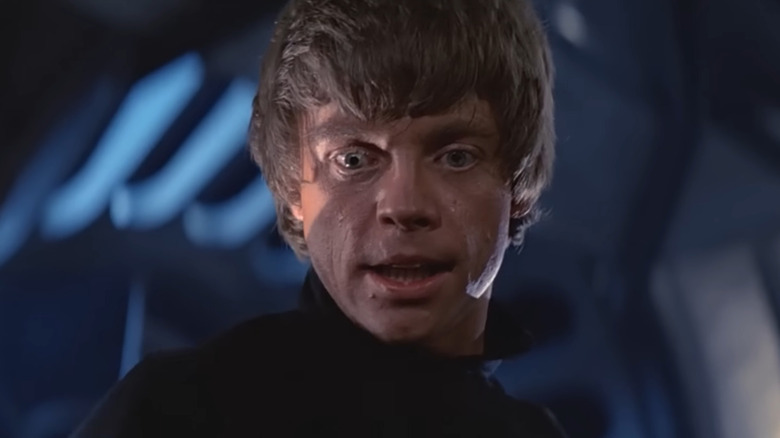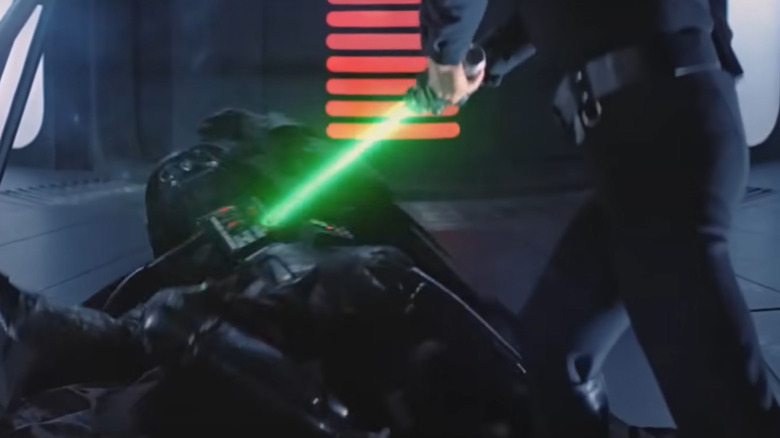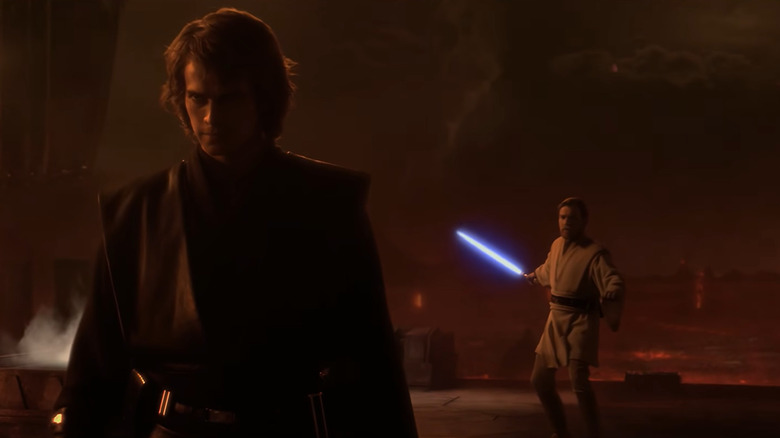George Lucas Had Blunt Advice For Luke And Vader's Final Star Wars Lightsaber Duel
Most film franchises seem to insist on the escalation of stakes. The first Avengers film centered around saving New York from a horde of aliens; "Infinity War" focused on protecting the entire known universe. This desire to raise the stakes with each new entry often backfires, like when the "X-Men" prequel movies centered their third film on another sprawling end-of-the-world storyline, after two movies in a row where the entire world was at stake. "X-Men: Apocalypse" was the perfect opportunity for a breezier, more slice-of-life storyline, but it's not what fans got.
In the original draft of "The Empire Strikes Back," Luke's final confrontation with Darth Vader and The Emperor was originally supposed to abide by this same rule. For their rematch in the climax of the next film, Director Richard Marquand's first plan was to make the scene "bigger than the fight in 'Empire,'" as he explained in "The Making of Star Wars: Return of the Jedi."
Just based on how the rest of the franchise has played out, it's easy to imagine a version of that scene where Luke was doing way more flips and spins, or where The Emperor started swinging his own lightsaber around. Instead, the sequence was remarkably restrained. The Emperor largely stayed in his throne and never picked up his lightsaber, a move that might sound anti-climactic, but which helped him maintain his position as an ominous, larger-than-life character. By denying us the sort of scenes "Revenge of the Sith" would give us 22 years later, "Return of the Jedi" let The Emperor keep his mystique.
Thanks, George!
The credit for this restraint goes to none other than George Lucas. "George said that it doesn't have to be bigger, because basically it can't be," Marquand said. "George is very blunt. He said, 'It's just a couple of guys banging sticks against each other. Don't worry about that. It is bigger because of what is going on in their heads. That is what makes it bigger.' That was nice, because then I saw exactly what he meant and I think up to that point I had missed a trick."
In the end, the scene was all about Luke and Vader's internal battles, not about the flashiness of anyone's Jedi powers. Luke's most "badass" moment is when he chops off Vader's hand; it's a satisfying parallel to what happened with Luke's hand last movie, but it's also a worrying sign that Luke's embraced the dark side. As Marquand described the scene: "Luke goes through sort of three changes during the fight. One is just straightforward anger. The next is not wanting to fight and withdrawing. And then the next one is, you son of a b**ch, okay, I'm going to kill you. So it's three different fights." The emotional stakes were so clear that the special effects department didn't exactly need to go overboard to make it a satisfying showdown.
Luckily The Emperor is there to needlessly gloat over Luke's descent to the Dark Side, which snaps Luke out of it and convinces him to return to the light. Luke ends up beating Vader not by killing him, but by embracing Old Ben Kenobi's pacifist ways. It's by letting himself be tortured by The Emperor that Vader finally snaps out of it and returns to the light as well.
The tragedy of Darth Lucas the Wise
"If he gives in to the dark side he will become like his father, and if he doesn't give in he will probably be killed," Marquand also said. "It is this conflict that will make the scene very exciting, indeed." It's an interesting point, one that makes Lucas's direction throughout the prequel series far more frustrating. While the prequels featured plenty of contemplation over the nature of light vs. dark, those contemplations rarely ever factored into the lightsaber battles themselves. When Obi-Wan and Qui-Gon were fighting against Darth Maul in "The Phantom Menace" there was never any sense that anyone's soul was at stake there. Obi-Wan's killing of Maul is a straightforwardly satisfying moment of revenge for Qui-Gon's death, nothing more.
But the irony of Lucas's change of approach over the years stings hardest with that final battle in "Revenge of the Sith," where Anakin and Obi-Wan have their climactic confrontation on the volcanic planet of Mustafar. It's the exact opposite of the final battle between Luke and Vader: The emotional stakes are overshadowed by the special effects to an almost absurd, comical degree. Anakin and Obi-Wan don't just fight for eight minutes straight, but they do so while jumping from one over-the-top obstacle to another. We know the circumstances behind the prequels were very different from those behind the original trilogy, but still: When making the prequels, it would've been nice if Lucas had listened to his own advice twenty years earlier.


